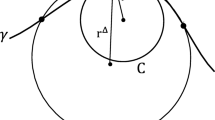Abstract
A refinement of the method of differential invariant signatures for object recognition is presented. The value of the method lies in its compromise between local and global identifying properties, thereby allowing us to distinguish non-congruent curves whose Euclidean signatures have identical trace.



Similar content being viewed by others
Notes
“Non-overlapping” means they have at most one endpoint in common.
In [10], the older term “classifying submanifold” is used in place of “signature submanifold”.
As noted above, one could experiment with other (weighted) norms, but the Euclidean norm suffices for our purposes.
References
Boutin, M.: Numerically invariant signature curves. Int. J. Comput. Vis. 40, 235–248 (2000)
Calabi, E., Olver, P.J., Shakiban, C., Tannenbaum, A., Haker, S.: Differential and numerically invariant signature curves applied to object recognition. Int. J. Comput. Vis. 26, 107–135 (1998)
Cartan, É.: Les problèmes d’équivalence. In: Oeuvres Complètes, part II, vol. 2, pp. 1311–1334. Gauthier-Villars, Paris (1953)
Fels, M., Olver, P.J.: Moving coframes. II. Regularization and theoretical foundations. Acta Appl. Math. 55, 127–208 (1999)
Freedman, M.H., He, Z.-X., Wang, Z.: Möbius energy of knots and unknots. Ann. Math. 139, 1–50 (1994)
Guggenheimer, H.W.: Differential Geometry. McGraw-Hill, New York (1963)
Hoff, D., Olver, P.J.: Automatic solution of jigsaw puzzles. Preprint, University of Minnesota (2011)
Hoffman, D.D., Richards, W.: Parts of recognition. Cognition 18, 65–96 (1984)
Musso, E., Nicolodi, L.: Invariant signature of closed planar curves. J. Math. Imaging Vis. 35, 68–85 (2009)
Olver, P.J.: Equivalence, Invariants, and Symmetry. Cambridge University Press, Cambridge (1995)
Olver, P.J., Sapiro, G., Tannenbaum, A.: Differential invariant signatures and flows in computer vision: a symmetry group approach. In: Ter Haar Romeny, B.M. (ed.) Geometry-Driven Diffusion in Computer Vision, pp. 255–306. Kluwer Academic, Dordrecht (1994)
Richards, W., Dawson, B., Whittington, D.: Encoding contour shape by curvature extrema. J. Opt. Soc. Am. A 3, 1483–1491 (1986)
Wang, Y.: Smoothing Splines: Methods and Applications. Monographs Stat. Appl. Probability, vol. 121. CRC Press, Boca Raton (2011)
Wu, K., Levine, M.D.: 3D part segmentation using simulated electrical charge distributions. IEEE Trans. Pattern Anal. Mach. Intell. 19, 1223–1235 (1997)
Author information
Authors and Affiliations
Corresponding author
Additional information
Supported in part by NSF Grant DMS 08–07317.
Rights and permissions
About this article
Cite this article
Hoff, D.J., Olver, P.J. Extensions of Invariant Signatures for Object Recognition. J Math Imaging Vis 45, 176–185 (2013). https://doi.org/10.1007/s10851-012-0358-7
Published:
Issue Date:
DOI: https://doi.org/10.1007/s10851-012-0358-7




